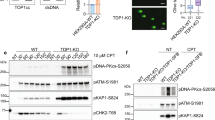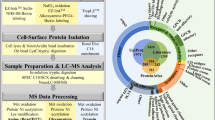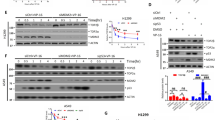Abstract
Recent studies have suggested an involvement of processing pathways for the initiation of cellular responses induced by topoisomerase-targeting drugs. Here, we showed that cellular exposure to camptothecin (CPT) induced formation of topoisomerase I cleavable complex (TOP1cc), degradation of TOP1 and activation of DNA damage responses (DDR). Transcription and proteasome-dependent proteolysis, but not replication, were involved in CPT-induced TOP1 degradation, while none of above three processing activities affected TOP1cc formation. Replication- and transcription-initiated processing (RIP and TIP) of TOP1cc were identified as two independent pathways, which contribute distinctly to various CPT-activated DDR. Specifically, in cycling cells, RIP-processed TOP1cc triggered the CPT-induced RPA phosphorylation. At higher CPT dosages, the TIP pathway is required for other DDR activation, including ATM, p53 and Chk1/2 phosphorylation. The TIP pathway was further demonstrated to be S-phase independent by using three nonreplicating cell models. Furthermore, the effect of proteasome inhibitors mimicked that of transcription inhibition on the CPT-induced activation of DDR, suggesting the involvement of proteasome in the TIP pathway. Interestingly, the TIP pathway was important for TOP1cc-activated, but not ionization radiation-activated ATM, p53 and Chk2 phosphorylation. We have also found that pharmacological interferences of TIP and RIP pathways distinctively modulated the CPT-induced cell killing with treatments at low and high dosages, respectively. Together, our results support that both RIP and TIP pathways of TOP1cc are required for the activation of CPT-induced DDR and cytotoxicity.
Similar content being viewed by others
Log in or create a free account to read this content
Gain free access to this article, as well as selected content from this journal and more on nature.com
or
References
Zhou BB, Bartek J . Targeting the checkpoint kinases: chemosensitization versus chemoprotection. Nat Rev Cancer 2004; 4:216–225.
Falck J, Coates J, Jackson SP . Conserved modes of recruitment of ATM, ATR and DNA-PKcs to sites of DNA damage. Nature 2005; 434:605–611.
Sancar A, Lindsey-Boltz LA, Unsal-Kacmaz K, Linn S . Molecular mechanisms of mammalian DNA repair and the DNA damage checkpoints. Annu Rev Biochem 2004; 73:39–85.
Li TK, Liu LF . Tumor cell death induced by topoisomerase-targeting drugs. Annu Rev Pharmacol Toxicol 2001; 41:53–77.
Pommier Y . Topoisomerase I inhibitors: camptothecins and beyond. Nat Rev Cancer 2006; 6:789–802.
Nitiss JL . Targeting DNA topoisomerase II in cancer chemotherapy. Nat Rev Cancer 2009; 9:338–350.
Connelly JC, Leach DR . Repair of DNA covalently linked to protein. Mol Cell 2004; 13:307–316.
Staker BL, Hjerrild K, Feese MD, et al. The mechanism of topoisomerase I poisoning by a camptothecin analog. Proc Natl Acad Sci USA 2002; 99:15387–15392.
Stewart L, Redinbo MR, Qiu X, Hol WG, Champoux JJ . A model for the mechanism of human topoisomerase I. Science 1998; 279:1534–1541.
Redinbo MR, Stewart L, Kuhn P, Champoux JJ, Hol WG . Crystal structures of human topoisomerase I in covalent and noncovalent complexes with DNA. Science 1998; 279:1504–1513.
Sordet O, Redon CE, Guirouilh-Barbat J, et al. Ataxia telangiectasia mutated activation by transcription- and topoisomerase I-induced DNA double-strand breaks. EMBO Rep 2009; 10:887–893.
Lin CP, Ban Y, Lyu YL, Liu LF . Proteasome-dependent processing of topoisomerase I-DNA adducts into DNA double strand breaks at arrested replication forks. J Biol Chem 2009; 284:28084–28092.
Lin CP, Ban Y, Lyu YL, Desai SD, Liu LF . A ubiquitin-proteasome pathway for the repair of topoisomerase I-DNA covalent complexes. J Biol Chem 2008; 283:21074–21083.
Fan JR, Peng AL, Chen HC, et al. Cellular processing pathways contribute to the activation of etoposide-induced DNA damage responses. DNA Repair (Amst) 2008; 7:452–463.
Zhang A, Lyu YL, Lin CP, et al. A protease pathway for the repair of topoisomerase II-DNA covalent complexes. J Biol Chem 2006; 281:35997–36003.
Takemura H, Rao VA, Sordet O, et al. Defective Mre11-dependent activation of Chk2 by ataxia telangiectasia mutated in colorectal carcinoma cells in response to replication-dependent DNA double strand breaks. J Biol Chem 2006; 281:30814–30823.
Wu JX, Liu LF . Processing of topoisomerase I cleavable complexes into DNA damage by transcription. Nucleic Acids Res 1997; 25:4181–4186.
Tsao YP, Russo A, Nyamuswa G, Silber R, Liu LF . Interaction between replication forks and topoisomerase-I-DNA cleavable complexes - studies in a cell-free Sv40 DNA-replication system. Cancer Res 1993; 53:5908–5914.
Hsiang YH, Lihou MG, Liu LF . Arrest of replication forks by drug-stabilized topoisomerase i-dna cleavable complexes as a mechanism of cell killing by camptothecin. Cancer Res 1989; 49:5077–5082.
Morris EJ, Geller HM . Induction of neuronal apoptosis by camptothecin, an inhibitor of DNA topoisomerase-I: evidence for cell cycle-independent toxicity. J Cell Biol 1996; 134:757–770.
Shao RG, Cao CX, Zhang HL, et al. Replication-mediated DNA damage by camptothecin induces phosphorylation of RPA by DNA-dependent protein kinase and dissociates RPA: DNA-PK complexes. EMBO J 1999; 18:1397–1406.
Desai SD, Zhang H, Rodriguez-Bauman A, et al. Transcription-dependent degradation of topoisomerase I-DNA covalent complexes. Mol Cel Biol 2003; 23:2341–2350.
Desai SD, Li TK, Rodriguez-Bauman A, Rubin EH, Liu LF . Ubiquitin/26S proteasome-mediated degradation of topoisomerase I as a resistance mechanism to camptothecin in tumor cells. Cancer Res 2001; 61:5926–5932.
Daroui P, Desai SD, Li TK, Liu AA, Liu LF . Hydrogen peroxide induces topoisomerase I-mediated DNA damage and cell death. J Biol Chem 2004; 279:14587–14594.
Subramanian D, Kraut E, Staubus A, Young DC, Muller MT . Analysis of topoisomerase I/DNA complexes in patients administered topotecan. Cancer Res 1995; 55:2097–2103.
Afshari CA, Barrett JC . Disruption of G0-G1 arrest in quiescent and senescent cells treated with phosphatase inhibitors. Cancer Res 1994; 54:2317–2321.
Li TK, Houghton PJ, Desai SD, et al. Characterization of ARC-111 as a novel topoisomerase I-targeting anticancer drug. Cancer Res 2003; 63:8400–8407.
Siu WY, Lau A, Arooz T, et al. Topoisomerase poisons differentially activate DNA damage checkpoints through ataxia-telangiectasia mutated-dependent and -independent mechanisms. Mol Cancer Ther 2004; 3:621–632.
Bakkenist CJ, Kastan MB . DNA damage activates ATM through intermolecular autophosphorylation and dimer dissociation. Nature 2003; 421:499–506.
D'Arpa P, Beardmore C, Liu LF . Involvement of nucleic acid synthesis in cell killing mechanisms of topoisomerase poisons. Cancer Res 1990; 50:6919–6924.
Furuta T, Takemura H, Liao ZY, et al. Phosphorylation of histone H2AX and activation of Mre11, Rad50, and Nbs1 in response to replication-dependent DNA double-strand breaks induced by mammalian DNA topoisomerase I cleavage complexes. J Biol Chem 2003; 278:20303–20312.
Liu LF, Desai SD, Li TK, Mao Y, Sun M, Sim SP . Mechanism of action of camptothecin. Ann N Y Acad Sci 2000; 922:1–10.
Adams J . The development of proteasome inhibitors as anticancer drugs. Cancer Cell 2004; 5:417–421.
Xu Y, Villalona-Calero MA . Irinotecan: mechanisms of tumor resistance and novel strategies for modulating its activity. Ann Oncol 2002; 13:1841–1851.
Canman CE, Lim DS, Cimprich KA, et al. Activation of the ATM kinase by ionizing radiation and phosphorylation of p53. Science 1998; 281:1677–1679.
Acknowledgements
We are grateful for the cell lines provided by Drs Won-Bo Wang and Shi-Chuen Miaw (National Taiwan University). We also thank Drs Carmela Palermo (Columbia University), Shu-Chun Teng and Fan-Lu Kung (National Taiwan University) for critical reading of the paper and their comments. This work was supported by grants from the National Science Council (NSC95-2320-B-002-097-MY3, 96-2320-B-002-081-MY3) and the National Health Research Institute (NHRI-EX97-9523BI).
Author information
Authors and Affiliations
Corresponding author
Additional information
( Supplementary information is linked to the online version of the paper on Cell Research website.)
Supplementary information
Supplementary information, Figure S1
Cellular exposure to CPT or metabolic inhibitors resulted in the dosage- and time-dependent activation of DDR or inhibition of replication, transcription or proteasome, but with only minimally effect on the protein levels of DDR molecules. (PDF 79 kb)
Supplementary information, Figure S2
Differential activation of CPT-induced γ-H2AX and Chk1345p by RIP- and TIP-processed TOP1cc. (PDF 65 kb)
Supplementary information, Table S1
A comparative analysis between the extent of CPT-induced DNA breakage and the activation level of different DDR molecules. (PDF 928 kb)
Rights and permissions
About this article
Cite this article
Huang, TH., Chen, HC., Chou, SM. et al. Cellular processing determinants for the activation of damage signals in response to topoisomerase I-linked DNA breakage. Cell Res 20, 1060–1075 (2010). https://doi.org/10.1038/cr.2010.95
Received:
Revised:
Accepted:
Published:
Issue date:
DOI: https://doi.org/10.1038/cr.2010.95
Keywords
This article is cited by
-
Activation of multiple proteolysis systems contributes to acute cadmium cytotoxicity
Molecular and Cellular Biochemistry (2022)
-
Targeting DNA repair pathways: mechanisms and potential applications in cancer therapy
Genome Instability & Disease (2020)
-
Selected ellipticine derivatives, known to target topoisomerase II, suppress the alternative lengthening of telomere (ALT) pathway in telomerase–negative cells
Journal of Cancer Research and Clinical Oncology (2020)



